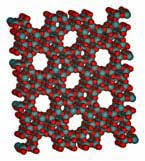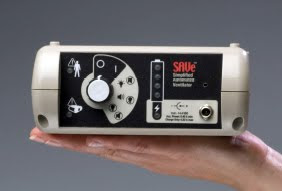In a 61-page opinion, the Board resolved three consolidated oppositions involving two competing flashlight manufacturers. Two of the oppositions, one brought by each party, concerned likelihood of confusion between certain word marks, while the third featured the issues of functionality and acquired distinctiveness of a product design or configuration.
Mag Instrument, Inc. v. The Brinkmann Corporation, 96 USPQ2d 1701 (TTAB 2010) [precedential].
 Opposition No. 91163534:
Opposition No. 91163534: In the first opposition, Mag Instrument opposed Brinkmann's application to register the mark
MAGNUM MAXFIRE for "hand-held portable lights, namely flashlights and spotlights," alleging likelihood of confusion with Mag's registered mark
MAG-NUM STAR for flashlight bulbs.
The Board began by rejecting, as usual, the
Morehouse defense pleaded by Brinkmann. Brinkmann pointed to its prior registration of MAGNUM MAX for "hand-held electric spotlights," However, the Board found that registered mark to be not "substantially identical" to the applied-for mark MAGNUM MAXFIRE, and the goods not "substantially the same," as required by
Morehouse. [The
Morehouse defense seems to be available only when you don't really need it:
i.e., when you already have a registration for virtually the same mark and goods. -
ed.]
Turning to the
du Pont analysis, the Board found that the dominant element of each mark is MAGNUM, and therefore that the marks are "highly similar in appearance, sound and connotation, and that the similarities in the overall commercial impression engendered by the marks as a whole greatly outweigh the differences." As to the goods, the Board found them to be complementary and related.
Brinkmann pointed to the 25 years of use of its MAGNUM MAX mark without any incident of actual confusion, but MAG noted the difference in the Brinkmann marks and goods and the Board refused to extrapolate this lack of actual confusion regarding MAGNUM MAX forspotlights to the MAGNUM MAXFIRE mark for flashlights.
And so the Board found confusion likely and sustained this opposition.
Opposition No. 91164340: Brinkmann opposed Mag's application to register the mark
MAG STAR for flashlights and flashlight accessories in view of the registered mark
MAXSTAR for "electric lanterns".
Mag tried to use a "family of marks" argument in defense, contending that, because of the alleged fame of the "MAG" family of marks, consumers would understand that the product came from Mag. The Board, however, pointed out once again that the family of marks doctrine is not available as a defense in an
inter partes proceeding.
 Family of Marx
Family of MarxIn sum, the Board found the marks "very similar" and the goods related. Ergo, it sustained the opposition.
Opposition No. 91164340: Brinkmann challenged Mag's attempt to register the product design mark shown below, for flashlights, the proposed mark consisting of "two bands that encircle the barrel of the flashlight." Brinkmann maintained that this configuration is functional, and if not, lacks acquired distinctiveness. The Board agreed on both counts.

Brinkmann contended that the ring design is "necessary to charge the flashlight and the reason that the charging feature works." The Board applied the
Morton-Norwich factors, finding that the first three pointed in Brinkmann's favor. Mag urged that the mark consists of "two bands that are visibly contrasting from the rest of the flashlight," but the Board observed that there was no indication in the application that the bands contrast with the barrel of the flashlight.
The Board reviewed an expired utility patent and concluded that "the features of [the proposed mark] are fundamentally covered by the expired patent," and that this patent "discloses the utilitarian advantages of the underlying mark, i.e., the two bands."
As to the second factor, the Board found that Mag had touted "several advantages of the dual bands": "you can get 360 degree contact ...
no matter how you place the flashlight in the charger." As to alternative designs, Mag offered only some theoretical possibilities and none included the 360-degree feature.
Finally, the evidence was inconclusive regarding whether the Mag design results in an easier of less expensive manner of production.
The Board concluded that the proposed mark is functional.
For purposes of completeness, the Board then considered Mag's Section 2(f) evidence of acquired distinctiveness, finding it inadequate. According to the Board, Mag had to show that "the primary significance of the two banks or recharging rings in the minds of the consumers is not the utilitarian parts of the flashlight but the source of the flashlight, in order to establish acquired distinctiveness." [Query: Couldn't it be both utilitarian and still be a source indicator? Are (
de facto) functionality and acquired distinctiveness mutually exclusive? -
ed.]
The Board once again pooh-poohed the probative value of form declarations. [Does the Board realize how hard it is to get anyone to sign even a form declaration, let alone expect the declarant to craft his or her own declaration?
ed.] The Board also observed that only one of the declarants was an end consumer, the others being sales reps or employees of retail companies.
The Board further pooh-poohed Mag's indirect evidence - sales and advertising figures - particularly harping on what it found to be "most damaging" to Mag's case: the lack of "look for" advertising. [Trademark attorneys harp on this all the time, but do clients pay attention? No. -
ed.]
And so the Board ruled that, in the alternative, Mag had failed to prove acquired distinctiveness for its proposed mark.
TTABlog comment: What if Mag files a new application to register
contrasting bands. Would that survive a functionality challenge? Stir in some "look-for" advertising and there you have it.
Text Copyright John L. Welch 2010.







































